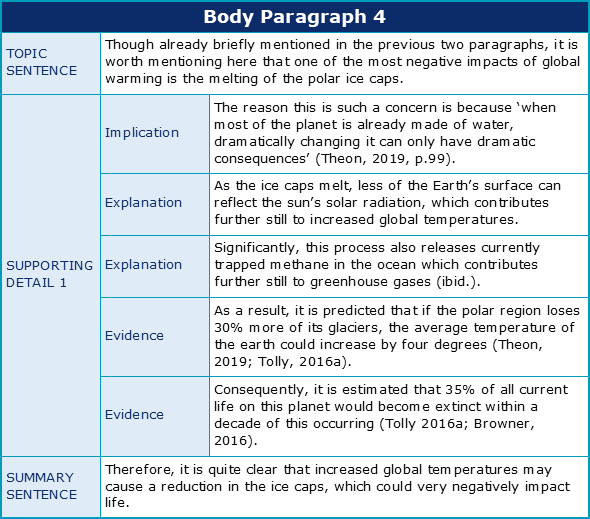How can I add evidence, examples and explanation?

This is the second of three chapters about Supporting Details. To complete this reader, read each chapter carefully and then unlock and complete our materials to check your understanding.
– Remind the reader of the significance of supporting details
– Practice identifying support-detail elements in authentic academic body paragraphs
– Consider the balance of voice in body paragraphs
Before you begin reading...
-
video and audio texts
-
knowledge checks and quizzes
-
skills practices, tasks and assignments
Chapter 2

In Chapter 1 of this short reader on supporting details, we introduced the various essay elements which are useful in a body paragraph. We then focussed specifically on those details, demonstrating how evidence, examples and explanation could be added to a topic-sentence main idea. Because these details are used to inform and persuade the reader of a particular viewpoint through the inclusion of source-based information, they are an integral aspect of successful academic writing. In this second chapter, we next look at paragraphs 2 and 4 from our example evaluative essay on global warming to see how the various supporting-detail elements can be effectively used.
How many supporting details?
Students often question their tutor about how many supporting details they should provide in a body paragraph, and while there’s no guaranteed formula here, the general answer is that there should be between one and three supporting details for each body-paragraph main idea – with two being the optimum number. In truth, what’s more important than counting how many supporting details you’ve included is carefully following the three pieces of guidance listed below:
- Make sure that each supporting detail you provide includes a variety of elements, such as evidence, examples, explanations, implications, solutions and effects.
- Make sure that each supporting detail you provide is directly connected to the topic-sentence main idea of that paragraph, which should itself be directly connected with your introductory paragraph’s thesis statement. Without a clear semantic connection between these elements, your reader will likely be confused about precisely what you are arguing and your essay’s persuasiveness (and grade) will go down.
- Make sure that your supporting details favour a deeper rather than a shallower investigation: Provide too many supporting details and your body paragraph will begin to feel like a list; provide too few, and your body section will not be a comprehensive enough investigation to make for worthwhile or convincing reading.
To exemplify supporting details in action, carefully study the second body paragraph below from our example evaluative essay on global warming. This paragraph demonstrates two supporting details and a number of supporting-detail elements:

Which supporting-detail elements?
Our example body paragraph above clearly demonstrates how one supporting detail may be comprised of a number of elements, most commonly (though not exclusively) in the form of evidence, examples, explanations and implications. To write an effective supporting detail you should therefore aim to include a variety of these elements. In truth, however, considerations of how many or which type are wholly dependent on the research you’ve conducted and the details being presented.
For example, a student may wish to present evidence about their main idea in the shape of statistics or facts as these can be very convincing, and they may wish to then further explain and contextualise that evidence or unravel a claim they’ve previously made. Explanation is very important for your reader, particularly as they may not have done as much background research as you and could have a more limited understanding of your topic. Finally, like evidence, the inclusion of real-life examples and case studies can also be very persuasive, such as how our example paragraph above refers to the specific species (polar bears and penguins) that are affected by global warming. Such examples help to ground the argument in reality and allow the reader to better connect with your supporting details.

How should I balance writer/source voice?
One final benefit of varying supporting-detail elements that merits discussion is how such variation allows you to better balance ‘voice’ in a body paragraph. As our short reader on balancing voices explains, it is important that the source voice and writer voice are distinct and well-balanced in a piece of academic writing. Take a look at body-paragraph four from our example essay below to see how this is achieved in the singular supporting detail about the affects of polar warming on the world’s ice caps:

By studying this paragraph carefully, you should be able to see how the writer’s voice is very clear in the topic and summary-transition sentences. A clear writer voice like this should be lacking any citations, as this voice type is used to introduces the writer’s ideas and opinions and to summarise the key discussion points. Source voice, on the other hand, identified by the inclusion of integral or non-integral citations, is much more commonly used with supporting details. This is because such support will usually require information taken from other sources.
However, students should note that even supporting details can and should use a mixture of source voice and writer voice. By taking a look at the two explanations used in this paragraph more closely, we can see that the first is in the writer’s voice while the following explanation is taken from a source (Theon, 2019). This is because the first explanation is common knowledge and does not require any citation, whereas the writer wishes to indicate in the second explanation that the specifics of this explanation are taken directly from another author’s research. It is of course more convincing for writer’s to include source-based information in their essays in this way.

For more information about the implications used in these example body paragraphs, continue on to our third and final chapter about supporting details. At this point, you may also wish to unlock and download our related Chapter 1 and Chapter 2 worksheets to check your progress and understanding.
To reference this reader:
Academic Marker (2022) Supporting Details. Available at: https://academicmarker.com/essay-writing/body-paragraphs/supporting-details/ (Accessed: Date Month Year).
Downloadables
Once you’ve completed all three chapters in this short reader about Supporting Details, you might then wish to download our Chapter Worksheets to check your progress or print for your students. These professional PDF worksheets can be easily accessed for only a few Academic Marks.
Chapter 1 explores the topic: What are supporting details in a body paragraph? Our Chapter 1 Worksheet (containing guidance, activities and answer keys) can be accessed here at the click of a button.
Chapter 2 explores the topic: How can I add evidence, examples and explanation? Our Chapter 2 Worksheet (containing guidance, activities and answer keys) can be accessed here at the click of a button.
Chapter 3 explores the topic: Why are implications important in body support? Our Chapter 3 Worksheet (containing guidance, activities and answer keys) can be accessed here at the click of a button.
To save yourself 2 Marks, click on the button below to gain unlimited access to all of our Supporting Details Chapter Worksheets. This All-in-1 Pack includes every chapter, activity and answer key related this topic in one handy and professional PDF.
Collect Academic Marks
-
100 Marks for joining
-
25 Marks for daily e-learning
-
100-200 for feedback/testimonials
-
100-500 for referring your colleages/friends